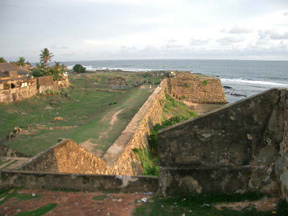
| Home |
| Where is Fort Galle? |
| Galle City |
| Galle Fort |
| Travelling Around |
| Places to See |
| Best Places to Stay |
| Shopping |
| 2004 Tsunami |
| Galle, Sri Lanka Today |
| Useful Resources |
| Resources |
The Galle Fort – A World Heritage Site
 A visit to the city of Galle will not be complete without a stroll through the historic and romantic walled streets of the Galle Fort. Occupying a total land area of 36 hectares, the Galle Fort has maintained an atmosphere of tranquility and history that pretty much reflects the Dutch period.
A visit to the city of Galle will not be complete without a stroll through the historic and romantic walled streets of the Galle Fort. Occupying a total land area of 36 hectares, the Galle Fort has maintained an atmosphere of tranquility and history that pretty much reflects the Dutch period.
Built by the Portuguese in the 16th century as a way to protect the city from invading Tamils, the Galle Fort was taken over by the Dutch in 1640, its defense system further fortified and improved. Many of the buildings one can see in the Galle Fort today are reminiscent of buildings that stood there during the Dutch Era most of which had pillared verandas and a lot of which were old-style mansions that belonged to sea merchants.

At present, the Galle Fort remains the only working fort built by European invaders in South and Southeast Asia which effectively combined the influences of Dutch architecture with South Asian traditions. Much of the way the Galle Fort was constructed and looks today can be attributed to the efforts of its Dutch colonizers. As a model showcase of the unique and impressive merging of European influences with South Asian culture, the United Nations Educational, Scientific and Cultural Organization (UNESCO) recognized and listed the Galle Fort as a World Heritage Site in 1988.
Today, the city of Galle is divided into Old Galle represented by the Galle Fort and its environs and located north of the Colombo-Matara road; and New Galle which is the commercialized and modernized part of the city on the other end. In between these two distinct parts of the city is a strip of open land formerly known as the Esplanade but which is now the Galle International Stadium where international cricket competitions are held. This strip of land was left open to insure that no distracting modern structure would be built beside the historic Galle Fort.